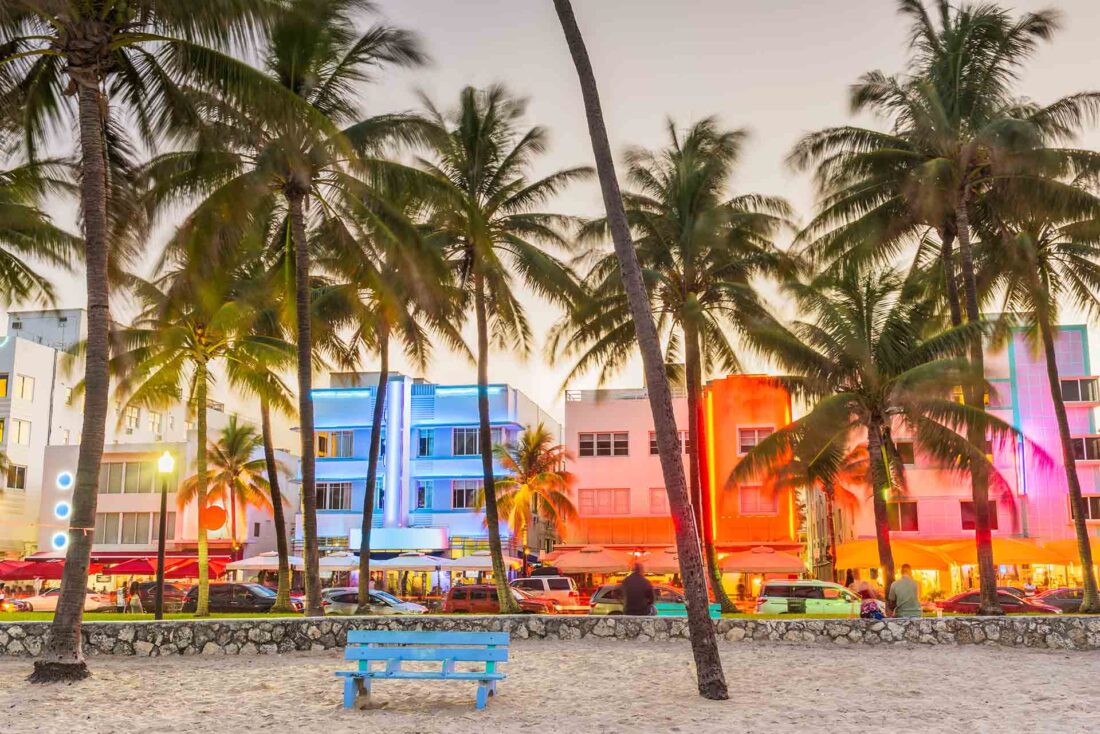If you’re considering moving to Miami, it’s always important to know what you can expect. Knowing the cost of living in Miami is excellent preparation, and you’ll be able to make your final decision based on what your calculator says.


Why You Should Choose Miami
It’s the cultural, economic, and financial center of South Florida spreading on 56 square miles. All the hotels, lots of beaches, shopping malls, lively nightlife, and countless activities lure visitors and future residents to this fantastic city. The population has been slowly growing through the years, and currently, almost 471k people reside there according to 2020 data. That makes it one of the most populous metro areas in America.
Why Live in Miami?
Diverse culture, great weather all year long, more than 800 parks, and nonstop fun are just some of the perks of living here. You’ll have plenty of job opportunities since we’re talking about a place that is home to many international and American companies. Commuting is well organized, and there are many options for public transport. There are more than 95 routes of Metrobus and 1,000 buses in operation, and a 25-mile rail system for Metrorail, both for $2.25 a trip. Metromover and Trolley are free, and most of the community is walkable.
You’ll have access to many different forms of entertainment, and you’ll find many active communities. World-class healthcare and health services are at your fingertips, and you should know that there are no income, inheritance, and estate taxes. Sounds pretty good for a destination to move to, right? Let’s see how much all of that can cost so you can be sure if Florida’s largest community is the one for you.


Cost of Living in Miami, Florida – Essential Data
Let’s check how much are the necessary costs. You’ll need a place to live in, food and transportation on a daily basis, and some fun from time to time. We’ll list the expenses of all of that for you.
Housing Prices, Rent, and Utility Expenses
Based on data from Numbeo, monthly rent for a one-bedroom apartment in the city center is around $1,800. If you rent the same sized apartment outside of the center, you’ll pay $500 less on average. Renting a three-bedroom apartment in the center will cost you $3,300 and outside the center $2,400 per month. Median rent is less than $1,100, which is higher than the national average by $100, and most people rent their places – as many as 70%, to be precise. You don’t have to be in Florida to be able to find the right spot. Learn how to get an apartment out of state and be prepared once you relocate.
If you wish to buy an apartment, the price per square foot in the city center is a bit less than $390. Outside of the center, the cost of the square foot would be around $230. The median home value in 2020 is more than $270,000. These numbers might be hard to swallow but bear in mind that the average prices of the housing also include the costs of homes in some of the city’s wealthiest and most exclusive neighborhoods. That’s why the housing expenses are 44% higher than in the rest of the US.
As for utilities, the expenses for power vary during the year, since you won’t need heating in the winter. Summers will raise your bill because it can hit 90 degrees during the day, so you’ll need to keep an air conditioner on. Essential utilities like electricity, heating, cooling, water, and garbage for a 915-square-foot apartment are around $130. One minute of prepaid mobile tariff is $0.04, and your phone bill will be about $175 a month. The internet is less than $65. The hourly rate for cleaning help is around $16. You can expect to get a $150 bill per month if you have a 1,000-square-foot apartment.
How Much Is Food?
It’s 5% more expensive than the US average. The price of a meal in an inexpensive restaurant is $15, but a basic lunchtime menu with a drink in the business district is $18. A three-course meal for two people in a mid-range restaurant is $65. If you wish to cook for yourself and you want a healthy meal, you’ll pay a bit more than $5 for 1 lb of boneless chicken breast, $6 for 16 oz of local cheese, and less than $3 for 2 pounds of potato. If you want a bottle of good quality red table wine, you’ll need $17. For six pounds of fruit, for example, apples, bananas, and oranges, you’ll need around $9.5. One bottle of milk is less than a dollar, and a loaf of fresh white bread is less than three bucks. A carton of eggs is around $2.
Cost of Transportation
As we mentioned before, commuting is easy here. A monthly pass for public transport is around $110, and a one-way ticket for local transport is $2.25. If you call a taxi, a start costs around $3, and a mile of the ride will be less than $3. Cabs can be expensive, and a 5-mile ride on a business day is $19. Transportation is one of the very few things in Little Cuba that cost less than the US average – you’ll pay $0.72 for a 1/4 gallon of gas. Your expenses will differ depending on which type of transportation you choose. For drivers, the most significant expense will be car insurance, and for example, tire balancing costs $67. For a new car, you’ll need around $20,000.
Prices for Recreation, Sports, and Leisure
Endless options for recreation and having some fun have their costs as well. If you want to go and see a movie, a ticket will be a bit less than $14, and a game of bowling is $23. Gym membership for one month in the business district is $45; renting a tennis court for one hour on the weekend is a bit less than $18. Nightlife options are abundant, so for a cocktail in a nightclub, the price would be somewhere around $15, and one pint of domestic draught beer is $6. A basic dinner out for two in a neighborhood pub is $49.


Healthcare Expenses
Since it’s one of the leading retirement places in the United States, it’s no wonder that Miami’s health care is one of the best in the world. Healthcare in the Magic City is 3% lower than the national average. For a visit to the doctor’s, you’ll need a bit more than a hundred bucks; dentist visits cost a bit less – $92, and an optometrist (in case you need it) will be $100. A vet visit is a bit more than $50.
Cold medicine for six days like Tylenol, Frenadol, Coldrex, or similar brands are $6, and one box of antibiotics is $21.
Good News – You’ll Have Low Taxes
Due to the expenses listed above, you might already be thinking about saving money. One of the greatest things about FL is that low taxes can help you balance the expenses. There is no state income tax in Florida, and that will save you a lot of money, but you’ll still need to pay federal income taxes. Sales tax is 7%, which is slightly less than in other parts of the country. Property taxes vary depending on the area you choose, but you can receive a discount on property taxes if you pay your bill early.


What’s the Job Situation and the Average Income?
Wondering how much money you can make if you relocate to Little Cuba? You should know that the average annual salary is $62k, and a bit less than $3,450 monthly after taxes. When it comes to popular jobs, consider the following: Operations, Project, and Marketing Manager. The salary for these occupations ranges between $37k and $122k per year. If you move there and you don’t have a job yet, check out how to get a job in a new city.
University of Miami (UM), Florida International University (FIU), and University of Miami School of Medicine are employers that hire a significant number of residents. The Port of Miami is the busiest and the largest passenger port in the world, so if you’re looking for a job in the travel or hospitality industry, you’ll get plenty of options. The unemployment rate is at an astonishing 1.8% according to data from the US Bureau of Labor, and the median household income is $42,000.
How Much Money Will You Need Living in This Florida City?
If you’re moving with children, and you’re a family of four, your monthly costs without the rent will be less than $3,500. A single person monthly costs would be $960 without the housing expenses. The prices vary depending on what kind of activities you wish to have and which neighborhood you choose. Bear in mind that you might need more than the median household income to live comfortably.


Is Miami Expensive? We Compared the Prices to Other FL Cities
If you want to move to Florida, but you’re not sure about the exact destination, take a look at the difference between its cities. When we compare Miami to the other cities in FL, it is more expensive than Orlando and Fort Lauderdale. When comparing Tampa and Miami, only the groceries were more expensive in Tampa by 3.70%, and the situation with Jacksonville is slightly different. In that community, restaurant and grocery prices are higher than in Magic City. With that in mind, it would be good to turn on the calculator and check if this is affordable for your budget.
Higher Prices for High-Quality Lifestyle
Magic City is somewhat more expensive than the national average, but it also does offer more. So many amenities make this area irresistible – tennis courts and golf courses, parks, pools, and a variety of programs and classes for children and adults of all ages. Even though the temperature is rarely below 50°F, you can even go ice skating. It has the best affordable nightlife with happy hours. If you’re moving with a dog, you’ll find a number of designated Bark Parks and a Bark Beach where your furry friend can enjoy an off-leash walk.
There’s a good choice of clubs for singles and many pubs for those who love craft beer. There are many hotels with beach access, art galleries, retail shops, eateries, and historic neighborhoods like the Art Deco district. Moving to Miami would mean that the fun and the good time never stop!


Moving Expenses – Don’t Forget About Them
Calculating your budget for relocation will need to have one more item – the expenses of moving out of the state. Find a company that you can trust, based on the previous experience or reviews and book a place on their schedule. You can compare the costs of different companies and choose the best one. Moving services can cost quite a bit, and if you decide to purchase packing services as well, or to transport your vehicle with you, that will increase the cost. Consider buying insurance if you wish to move something of great value. A good moving company will provide all that, and you’ll have a stress-free move!







